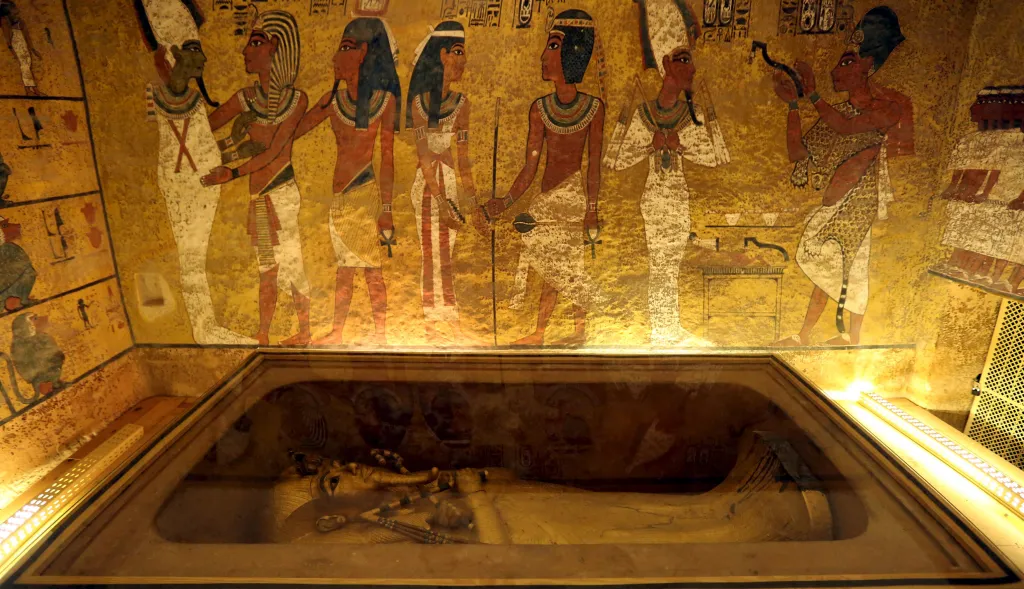The Curse of Tutankhamun: Is the mystery behind the deaths of those involved and the hidden truth being unravelled?
Some archaeologists, ignoring warnings about the terrible curse that hung over the mummy of the youngest pharaoh of ancient Egypt, committed the “sacrilic” act of disturbing Tutankhamun’s coffin. Many of these people died mysteriously and the true cause remains controversial.

Archaeologist Howard Carter made a shocking discovery about Pharaoh Tutankhamun’s tomb in 1922.
The tomb of Pharaoh Tutankhamun was discovered in 1922 by Howard Carter and his team of archaeologists. The number of mysterious deaths after Tutankhamun’s coffin was opened is revealed in the documentary “Top 10 Secrets and Mysteries” broadcast on Netflix.
“Most deaths can be explained medically, but six of the 12 people present at the opening of Tutankhamun’s coffin died mysteriously and still cannot be explained,” Express quoted the document as saying.
All of these cases died in mysterious and unfortunate ways, including murders, suicides, and accidents.
Mysterious deaths and accidents

George Herbert, 5th Earl of Carnarvon and financial backer of the excavation of Tutankhamun’s tomb
George Herbert, the 5th Earl of Carnarvon and financier of the excavation of Tutankhamun’s tomb, was the first to die mysteriously. Herbert died on 4 May 1923, after entering the tomb. The 5th Earl of Carnarvon died of blood poisoning, resulting from an infection from a mosquito bite. Some reports even said that when Herbert died, all the lights in his house mysteriously went out.
George Jay Gould I, an American financier, suddenly fell ill with fever after a visit to Tutankhamun’s tomb in 1923. A few months later, he died of pneumonia.
Archibald Douglas-Reid, who took X-rays of the mummy of Pharaoh Tutankhamun, fell ill shortly after entering the tomb and died on 15 January 1924 from a mysterious illness.
The first people to “disturb” the tomb of the youngest pharaoh of ancient Egypt

More dramatic was the case of Hugh Evelyn-White, a British Egyptologist and one of the first to enter the tomb of Tutankhamun, who hanged himself in 1924. He left a note written in blood that read: “I succumb to the curse that forces me to disappear forever.”
The most terrifying case was that of Bruce Ingham. Howard Carter, the first man to open Tutankhamun’s coffin, gave him a paperweight believed to be the mummy’s hand, and he wore a bracelet that read: “Whoever touches my body will be cursed.” Shortly after receiving the strange gift, Ingham’s house burned down in a fire. While it was being rebuilt, the house was swept away by a flood.
Many strange objects were found in Tutankhamun’s tomb.
Was the death of the “blasphemers” due to Tutankhamun’s curse?

Many mysterious deaths or disasters involving people involved in the excavation of Tutankhamun’s tomb caused many people to believe in Tutankhamun’s curse.
According to National Geographic, a theory has been proposed regarding the cause of Herbert’s death, suggesting that the fifth Earl of Carnarvon died from exposure to an ancient pathogen hidden in Tutankhamun’s coffin.
“Egyptian tombs contain not only mummies, but also many other things, such as meat, plants or even fruit, which were buried with the dead when they went to the afterlife. These things attract insects, mould, bacteria, pathogens… and remember that they last for thousands of years,” says Jennifer Wegner, an Egyptologist at the University of Pennsylvania (USA).
Several studies have shown that some ancient mummies contained molds, including at least two highly toxic species, Aspergillus Niger and Aspergillus Flavus. These can cause allergic reactions, such as blockages or bleeding in the lungs, and are especially harmful to people with weakened immune systems.
Some of the tomb walls also contained bacteria that attack the respiratory tract, such as Pseudomonas or Staphylococcus.
Objects and walls in ancient tombs often contain many harmful bacteria and molds.
Scientists also found ammonia, formaldehyde and hydrogen sulfide in the sealed coffin. In high concentrations, they can cause burning in the eyes and nose and symptoms of pneumonia. Severe cases can lead to death.
One discovery in Egyptian tombs was that many bats lived inside them. Bat droppings also contain fungi that can cause respiratory diseases.
Under the right conditions, the substances mentioned above can be lethal.
When opening coffins, archaeologists rarely wear masks or protective equipment.
According to Egyptologist Wegner, archaeologists rarely wear masks when entering tombs, even when opening coffins.
“In the archaeological projects I have been involved in, we don’t usually wear masks or other protective equipment. If we do, it is more to protect ourselves from dust than from bacteria or mould,” Wegner says. This could be the reason why so many people have contracted diseases and died mysteriously. Also, the suicides and fires said to be linked to the mummy’s curse could be mere coincidences.
The mummy of a woman in China, who was buried for 2,000 years, is surprising because her skin is still soft and…






